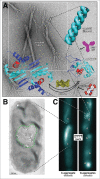RepA-WH1 prionoid: Clues from bacteria on factors governing phase transitions in amyloidogenesis
- PMID: 27040981
- PMCID: PMC4981189
- DOI: 10.1080/19336896.2015.1129479
RepA-WH1 prionoid: Clues from bacteria on factors governing phase transitions in amyloidogenesis
Abstract
In bacterial plasmids, Rep proteins initiate DNA replication by undergoing a structural transformation coupled to dimer dissociation. Amyloidogenesis of the 'winged-helix' N-terminal domain of RepA (WH1) is triggered in vitro upon binding to plasmid-specific DNA sequences, and occurs at the bacterial nucleoid in vivo. Amyloid fibers are made of distorted RepA-WH1 monomers that assemble as single or double intertwined tubular protofilaments. RepA-WH1 causes in E. coli an amyloid proteinopathy, which is transmissible from mother to daughter cells, but not infectious, and enables conformational imprinting in vitro and in vivo; i.e. RepA-WH1 is a 'prionoid'. Microfluidics allow the assessment of the intracellular dynamics of RepA-WH1: bacterial lineages maintain two types (strains-like) of RepA-WH1 amyloids, either multiple compact cytotoxic particles or a single aggregate with the appearance of a fluidized hydrogel that it is mildly detrimental to growth. The Hsp70 chaperone DnaK governs the phase transition between both types of RepA-WH1 aggregates in vivo, thus modulating the vertical propagation of the prionoid. Engineering chimeras between the Sup35p/[PSI(+)] prion and RepA-WH1 generates [REP-PSI(+)], a synthetic prion exhibiting strong and weak phenotypic variants in yeast. These recent findings on a synthetic, self-contained bacterial prionoid illuminate central issues of protein amyloidogenesis.
Keywords: Hsp70 chaperone; RepA-WH1; amyloid polymorphism; amyloid proteinopathy; bacterial prionoid; phase transitions.
Figures

Comment on
- doi: 10.1016/j.str.2014.11.007
- doi: 10.1038/srep14669
- doi: 10.1111/mmi.12518
- doi: 10.3389/fmicb.2015.00311
References
-
- Otzen D. Functional amyloid: Turning swords into plowshares. Prion 2010; 4:256-64; PMID:20935497; http://dx.doi.org/10.4161/pri.4.4.13676 - DOI - PMC - PubMed
-
- Romero D, Kolter R. Functional amyloids in bacteria. Int Microbiol 2014; 17:65-73; PMID:26418850 - PubMed
-
- DePas WH, Chapman MR. Microbial manipulation of the amyloid fold. Res Microbiol 2012; 163:592-606; PMID:23108148; http://dx.doi.org/10.1016/j.resmic.2012.10.009 - DOI - PMC - PubMed
-
- Bieler S, Estrada L, Lagos R, Baeza M, Castilla J, Soto C. Amyloid formation modulates the biological activity of a bacterial protein, J Biol Chem 2005; 280:26880-5; PMID:15917245; http://dx.doi.org/10.1074/jbc.M502031200 - DOI - PubMed
-
- Liebman SW, Chernoff YO. Prions in yeast. Genetics 2012; 191:1041-72; PMID:22879407; http://dx.doi.org/10.1534/genetics.111.137760 - DOI - PMC - PubMed
Publication types
MeSH terms
Substances
LinkOut - more resources
Full Text Sources
Other Literature Sources
Molecular Biology Databases
